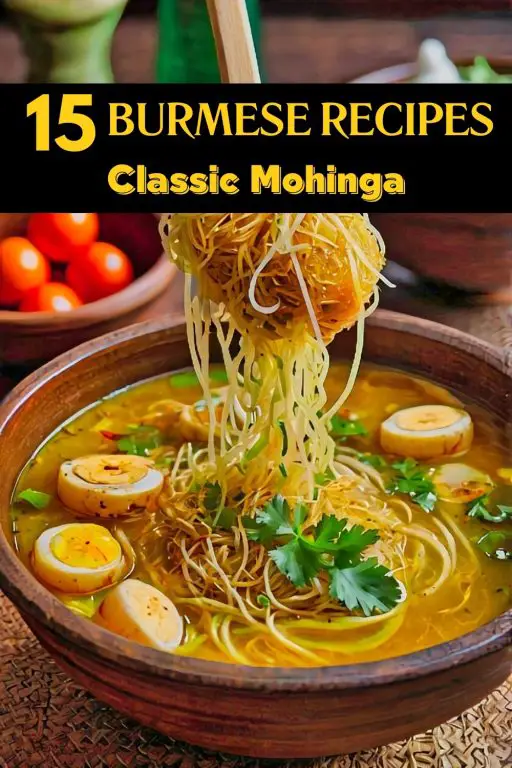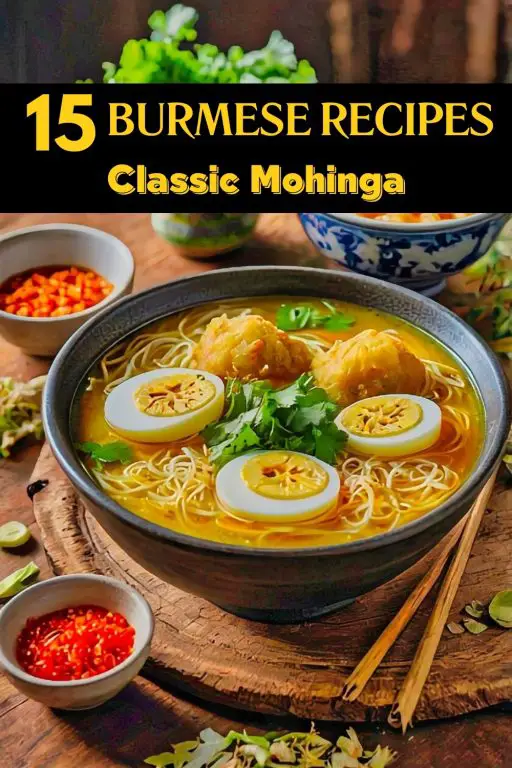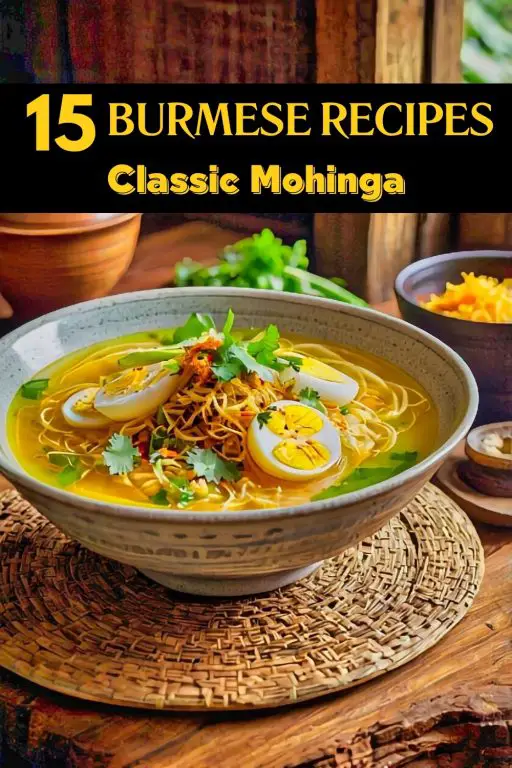Burmese Mohinga is one of the country’s most famous foods, and many people eat it every morning for breakfast. It usually has a base of rice noodles in a fish soup. This food is popular all over the country, but it’s especially popular near rivers, where fresh fish is easy to find. The Burmese Mohinga recipe is easy to follow but very rich. The soup gives the noodles a hearty texture that goes well with it.
When I tried the Burmese Mohinga recipe at a nearby restaurant for the first time, I noticed right away that it was very light. As usual for this dish, the soup wasn’t too thick, which let the flavors mix without being too strong. The soft, smooth texture of the rice noodles in the Burmese Mohinga recipe goes well with the slightly sour taste of the broth. We were able to get the recipe and learn more about how people in Myanmar usually eat it after we tried it.
People all over Myanmar like this food because it is easy to make and good for you. Its materials can be found in most parts of the country, and it’s a reflection of the way people live in agriculture in the country. Mohinga is an important part of everyday life in Myanmar because it is often sold by street sellers.
Ingredients For the Burmese Mohinga Recipe
For the Fish
White Fish
Chopped Onion
Minced Cloves Garlic
Bruised and Chopped Stalks Lemongrass
Peeled and Sliced Ginger
Turmeric Powder
Fish Sauce
Water
For the Soup
Chopped Onion
Minced Cloves Garlic
Vegetable Oil
Turmeric Powder
Chili Flakes
Chickpea Flour
Rice Noodles
Peeled and Sliced Hard-boiled Eggs
Chopped Cilantro
Chopped Mint
Chopped Scallions
Chickpea Fritters
Fried Onions and
Chili Oil
Cooking Instructions For the Burmese Mohinga Recipe
- To make the fish broth, combine the fish, onion, garlic, lemongrass, ginger, turmeric, fish sauce, and water in a large pot. Bring to a boil, then reduce the heat to low and simmer for 30 minutes.
- Remove the fish from the broth and set it aside to cool. Strain the broth through a fine-mesh sieve and discard the solids. Return the broth to the pot and keep it warm on low heat.
- Once the fish has cooled, remove any bones and skin and shred the meat into bite-sized pieces. Set aside.
- In a separate pan, heat the vegetable oil over medium-high heat. Add the chopped onion and garlic and sauté until soft and fragrant, about 5 minutes.
- Add the turmeric powder and chili flakes to the pan and stir to combine.
- In a bowl, whisk together the chickpea flour and 2 cups of water until smooth. Add the chickpea mixture to the pan and stir continuously to prevent lumps from forming.
- Add the fish broth to the pan, stirring to combine. Bring the mixture to a boil, then reduce the heat and simmer for 10-15 minutes, stirring occasionally, until the soup has thickened.
- Cook the rice noodles according to the package instructions and divide them among 8 serving bowls.
- Add the shredded fish to the soup and cook for another 2-3 minutes until heated through.
- Ladle the soup over the noodles in each bowl. Top with sliced hard-boiled eggs, chopped cilantro, mint, and scallions. Serve with fried chickpea fritters, fried onions, and chili oil on the side.
10 Reasons I love Burmese Food
Diverse Flavour Profiles
Burmese cuisine boasts a remarkable variety of flavours, from the tangy sharpness of fermented tea leaves in Laphet to the soothing warmth of coconut milk in Kaukswe. The balance between spicy, sweet, sour, and salty elements ensures that every meal offers a complex and satisfying taste experience. The use of ingredients like lemongrass, turmeric, and garlic further enriches the flavour spectrum, making each dish distinct and memorable.
Rich Use of Fresh Herbs and Spices
Fresh herbs like cilantro, mint, and basil, along with spices such as turmeric, ginger, and cumin, are central to Burmese cooking. These ingredients not only add depth and vibrancy to dishes but also enhance their nutritional value. The aromatic qualities of these herbs and spices create a sensory experience that is both refreshing and invigorating.
Unique Signature Dishes
Burmese cuisine is known for its iconic dishes, such as Mohinga (fish noodle soup), which is often regarded as the national dish. This rich, fragrant soup is a blend of fish, noodles, and spices, topped with crispy fritters and fresh herbs. Another standout is the Shan Noodles, featuring rice noodles in a spicy, savoury sauce. These unique dishes offer a taste of Burmese culture and tradition in every bite.
Versatility in Cooking Techniques
Burmese food showcases a range of cooking techniques, from stir-frying and boiling to steaming and deep-frying. This versatility allows for a diverse array of dishes, each prepared in a way that brings out the best in its ingredients. For example, the deep-fried fritters in Mohinga add a delightful crunch, while the steaming process in dishes like Kaukswe results in a soft, comforting texture.
Emphasis on Fresh and Local Ingredients
The use of fresh, locally-sourced ingredients is a hallmark of Burmese cuisine. Seasonal vegetables, herbs, and fruits are prominently featured, ensuring that meals are both flavourful and nutritious. This focus on local produce not only supports sustainability but also allows for a connection to the land and the people who grow the food.
Balanced Nutrition
Burmese meals are often well-balanced, incorporating a variety of food groups. For instance, a typical meal might include rice as a staple, accompanied by curries or stir-fries rich in proteins and vegetables. This combination provides a good mix of carbohydrates, proteins, and vitamins, contributing to a wholesome and satisfying diet.
Cultural and Historical Significance
Burmese food is deeply intertwined with the country’s history and culture. Many dishes have been passed down through generations, reflecting the traditions and culinary practices of different ethnic groups within Myanmar. Eating Burmese food provides a taste of this rich cultural heritage, making each meal a journey through history.
Comforting and Hearty Meals
Many Burmese dishes are known for their comforting and hearty qualities. Dishes like Kaukswe, with its rich coconut milk base and tender noodles, offer warmth and satisfaction. This comforting nature of Burmese food makes it ideal for both everyday meals and special occasions.
Affordable and Accessible
Burmese cuisine is often affordable, making it accessible to a wide range of people. Street food and local eateries offer delicious, budget-friendly options that allow people to enjoy authentic Burmese flavours without breaking the bank. This accessibility ensures that the cuisine can be enjoyed by everyone, regardless of their budget.
A Sense of Community
Sharing a meal of Burmese food is a social experience that brings people together. Whether it’s a family dinner or a gathering with friends, Burmese cuisine often features dishes that are meant to be shared, fostering a sense of community and connection. The communal nature of dining on dishes like Laphet and Mohinga highlights the importance of food in building relationships and creating memorable experiences.
Each of these reasons contributes to the deep appreciation and love for Burmese food, making it a cherished part of Myanmar’s cultural and culinary landscape.
5. Eating Healthy in Burma
Eating healthy in Burma, or Myanmar, is deeply intertwined with traditional dietary practices and a reliance on fresh, locally-sourced ingredients. The Burmese diet primarily revolves around rice, which serves as the staple component of most meals. This is typically accompanied by a variety of dishes that include vegetables, legumes, and lean proteins, reflecting a balanced approach to nutrition. Meals often feature an array of fresh vegetables such as leafy greens, beans, and squash, providing essential vitamins and minerals.
Burmese cuisine also incorporates a range of legumes and pulses, such as chickpeas and lentils, which are excellent sources of protein and fibre. Dishes like **Burmese chickpea salad** are not only nutritious but also showcase how traditional ingredients can be combined to create wholesome, satisfying meals. Additionally, seafood and lean meats are commonly used in curries and soups, contributing to a diet that includes a good balance of protein sources.
The use of herbs and spices, such as turmeric, ginger, and garlic, not only enhances flavour but also offers various health benefits. Turmeric, for example, contains curcumin, which is known for its anti-inflammatory properties. Similarly, garlic and ginger are known for their immune-boosting and digestive benefits.
Moreover, traditional Burmese meals often avoid excessive use of processed foods and sugars, focusing instead on whole, natural ingredients. This approach aligns with a healthy eating philosophy, promoting overall well-being. The traditional practice of using fresh ingredients and cooking methods such as steaming and boiling further supports a nutritious diet.
Overall, the emphasis on fresh produce, legumes, lean proteins, and beneficial spices in Burmese cuisine contributes to a balanced and health-conscious approach to eating. This traditional diet, rooted in local agricultural practices, offers a nutritious and satisfying way of eating that supports overall health and wellness.
FAQ For the Burmese Mohinga Recipe
Here are 5 FAQs with the keyword “Burmese Mohinga recipe”:
Q: What fish is commonly used in a Burmese Mohinga recipe?
A: In a traditional Burmese Mohinga recipe, freshwater fish like catfish is commonly used for its firm texture and ability to hold up in the broth. The fish is simmered in a rich broth made from rice flour, lemongrass, and turmeric, which gives Mohinga its distinct flavor. If catfish is unavailable, other white fish such as tilapia or cod can be used as substitutes. The fish is often broken down in the soup to distribute its flavor throughout the dish.
Q: How can I thicken the broth in a Burmese Mohinga recipe?
A: A Burmese Mohinga recipe typically uses ground toasted rice or rice flour to thicken the broth, giving it a hearty consistency. Adding the rice flour slowly while stirring helps to avoid lumps and ensures a smooth texture. The rice-based thickener not only adds body to the broth but also a mild, nutty flavor that complements the fish. If you prefer a thicker consistency, you can adjust the amount of rice flour or simmer the soup longer to reduce it.
Q: Can a Burmese Mohinga recipe be made gluten-free?
A: Yes, a Burmese Mohinga recipe is naturally gluten-free as it primarily uses rice flour as a thickening agent instead of wheat flour. The other ingredients, such as fish, lemongrass, turmeric, and various vegetables, are also gluten-free. It is important to check labels on condiments like fish sauce and other seasonings to ensure they do not contain gluten. By using gluten-free alternatives where necessary, the dish can be safely enjoyed by those with gluten sensitivities.
Q: What makes a Burmese Mohinga recipe different from other Southeast Asian noodle soups?
A: A Burmese Mohinga recipe is unique because of its fish-based broth and use of rice flour as a thickener, which sets it apart from other noodle soups like pho or laksa. The broth is seasoned with lemongrass, ginger, and turmeric, giving it a refreshing yet hearty flavor profile. The dish is traditionally served with rice vermicelli noodles and topped with a variety of garnishes, such as crispy fritters and boiled eggs. Mohinga is often considered Myanmar’s national dish and is commonly eaten for breakfast.
Q: What are common toppings or garnishes in a Burmese Mohinga recipe?
A: A Burmese Mohinga recipe is typically served with a range of garnishes that add texture and flavor to the dish. Common toppings include crispy split pea fritters, boiled eggs, fried garlic, and chopped cilantro. Some variations also include banana stem slices or crispy shallots for additional crunch. The toppings can be customized based on personal preference, allowing for a diverse combination of flavors and textures.

Burmese Mohinga
Equipment
- Large pot for making fish broth
- Fine-mesh sieve for straining broth
- Large pan for sautéing onions and garlic
- Whisk for mixing chickpea flour slurry
- Bowl for mixing chickpea flour slurry
- Cutting board & Sharp knife
- serving bowls
- serving bowls
Ingredients
For the Fish Broth:
- 2 lbs. white fish (such as cod or tilapia)
- 1 onion, chopped
- 4 cloves garlic, minced
- 2 stalks lemongrass, bruised and chopped
- 1 inch piece ginger, peeled and sliced
- 1 tbsp turmeric powder
- 2 tbsp fish sauce
- 8 cups water
For the Soup:
- 1 onion, chopped
- 4 cloves garlic, minced
- 2 tbsp vegetable oil
- 1 tbsp turmeric powder
- 1 tsp chili flakes (or to taste)
- 2 cups chickpea flour
- 1 lb. rice noodles
- 4 hard-boiled eggs, peeled and sliced
- ¼ cup chopped cilantro
- ¼ cup chopped mint
- ¼ cup chopped scallions
- Fried chickpea fritters (optional)
- Fried onions and chili oil, for serving
Instructions
- To make the fish broth, combine the fish, onion, garlic, lemongrass, ginger, turmeric, fish sauce, and water in a large pot. Bring to a boil, then reduce the heat to low and simmer for 30 minutes.
- Remove the fish from the broth and set it aside to cool. Strain the broth through a fine-mesh sieve and discard the solids. Return the broth to the pot and keep it warm on low heat.
- Once the fish has cooled, remove any bones and skin and shred the meat into bite-sized pieces. Set aside.
- In a separate pan, heat the vegetable oil over medium-high heat. Add the chopped onion and garlic and sauté until soft and fragrant, about 5 minutes.
- Add the turmeric powder and chili flakes to the pan and stir to combine.
- In a bowl, whisk together the chickpea flour and 2 cups of water until smooth. Add the chickpea mixture to the pan and stir continuously to prevent lumps from forming.
- Add the fish broth to the pan, stirring to combine. Bring the mixture to a boil, then reduce the heat and simmer for 10-15 minutes, stirring occasionally, until the soup has thickened.
- Cook the rice noodles according to the package instructions and divide them among 8 serving bowls.
- Add the shredded fish to the soup and cook for another 2-3 minutes until heated through.
- Ladle the soup over the noodles in each bowl. Top with sliced hard-boiled eggs, chopped cilantro, mint, and scallions. Serve with fried chickpea fritters, fried onions, and chili oil on the side.





3 comments
I couldn’t believe how easy and tasty this Mohinga turned out to be.
I cant believe they didnt mention the importance of using banana stems in the Mohinga recipe! It adds such a unique flavor and texture. Definitely a must-try addition next time.
I dont know about you guys, but I think the key to a good Mohinga recipe is getting the spice levels just right. Too bland and its boring, too spicy and its overpowering. What do you all think?
Comments are closed.